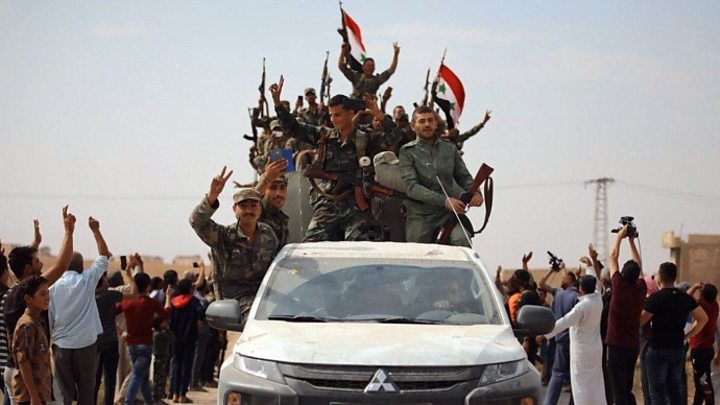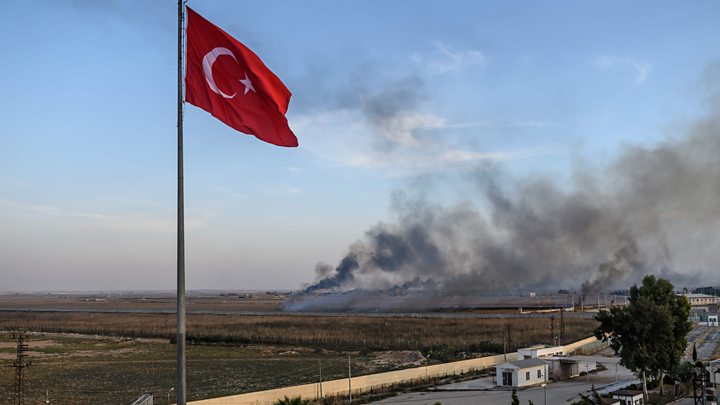Turkey-Syria offensive: Erdogan rejects US ceasefire call
The Turkish president says the operation will achieve its objectives, despite growing US pressure. …


Media playback is unsupported on your device
Turkish President Recep Tayyip Erdogan has rejected a US call for an immediate ceasefire in northern Syria, saying Turkey’s offensive will continue.
His comments come as US Vice-President Mike Pence and US Secretary of State Mike Pompeo prepare to fly to Turkey to try to broker a truce.
On Tuesday, Russia warned that it would not allow clashes to take place between Turkish and Syrian forces.
Turkey says its offensive aims to push Kurdish forces from the border region.
It considers elements of the Kurdish-led Syrian Democratic Forces (SDF) a terrorist organisation.
Ankara also says it wants to create a “safe zone” reaching about 30km (20 miles) into Syria to resettle up to two million Syrian refugees currently in Turkey.
However, Syrian forces – which are backed by Russia – advanced north at the weekend following a deal with the Kurds to try to hold back the Turkish operation.
The withdrawal of US troops from the region, announced last week, gave Turkey a “green light” for the offensive, critics of the Trump administration say.
The US has repeatedly denied this, and on Monday Washington announced sanctions on Turkish ministries and senior government officials.
Dozens of civilians have been killed in the operation so far and at least 160,000 have fled the area, according to the UN.
What did President Erdogan say?
“They say ‘declare a ceasefire’. We will never declare a ceasefire,” Mr Erdogan told reporters on Tuesday.
“They are pressuring us to stop the operation. They are announcing sanctions. Our goal is clear. We are not worried about any sanctions,” the president added.
Mr Erdogan is expected to meet Mr Pence and Mr Pompeo in Ankara on Thursday.
Mr Pence on Monday warned that the US sanctions against Turkey would worsen “unless and until Turkey embraces an immediate ceasefire” and negotiates a long-term settlement on the border.
US President Donald Trump has faced mounting pressure to take action against Turkey – a key Nato partner – including from Republicans usually loyal to his administration.
What’s the latest on the ground?
Syrian government forces on Tuesday entered the strategic town of Manbij, inside the area where Turkey wants to create its “safe zone”.

Media playback is unsupported on your device
Meanwhile, Turkish troops and pro-Turkish, anti-government fighters had also been gathering near Manbij.
Over the past two years, hundreds of US troops have visibly patrolled the strategic town, but they left earlier this week.
On Tuesday, Russia – a key ally of Syrian President Bashar al-Assad – said its forces were patrolling along the “line of contact” between Syrian and Turkish forces.
Moscow describes the Turkish offensive as “unacceptable”. On Tuesday, President Erdogan and his Russian counterpart Vladimir Putin discussed the issue in a phone call.
For now, Syrian forces have not been deployed between Tal Abyad and Ras al-Ain, where Turkey has focused its efforts.
How did we get here?
Kurdish-led forces have been a key ally of the US in the fight against the Islamic State (IS) group in Syria.
They described the US withdrawal, which preceded Turkish action, as a “stab in the back”.
There are fears the destabilisation could lead to a resurgence of so-called Islamic State (IS), as thousands of former fighters and their relatives are being detained in northern Syria.
Hundreds of IS family members are said to have already escaped from one camp.
Analysts say that apart from fighting IS, the Kurds were fundamental to the US in limiting the influence of rivals Russia and Iran and keeping some leverage on the ground.




